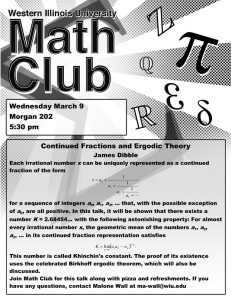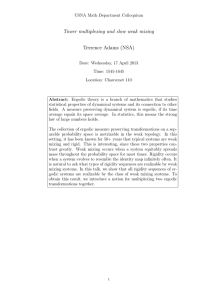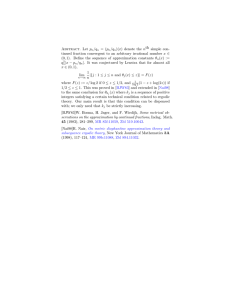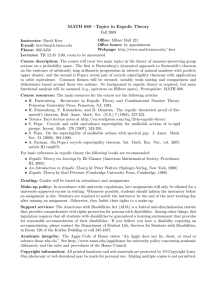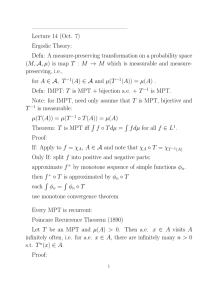Lecture 4 Recall Lemma from Poincare Recurrence Theorem:
advertisement
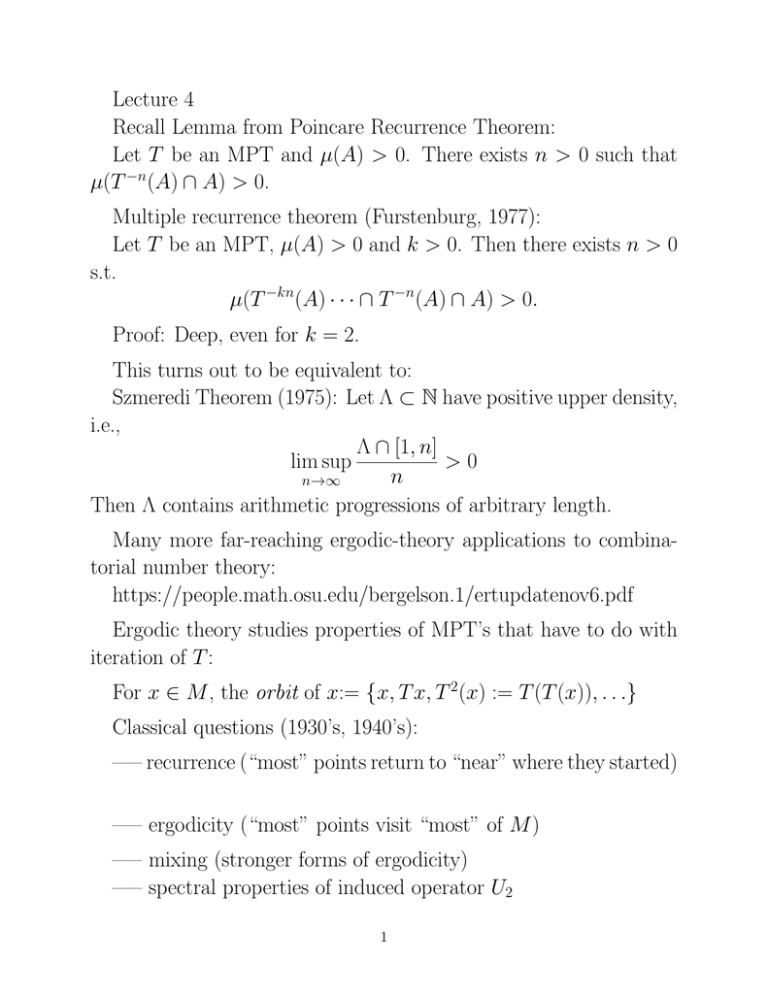
Lecture 4
Recall Lemma from Poincare Recurrence Theorem:
Let T be an MPT and µ(A) > 0. There exists n > 0 such that
µ(T −n(A) ∩ A) > 0.
Multiple recurrence theorem (Furstenburg, 1977):
Let T be an MPT, µ(A) > 0 and k > 0. Then there exists n > 0
s.t.
µ(T −kn(A) · · · ∩ T −n(A) ∩ A) > 0.
Proof: Deep, even for k = 2.
This turns out to be equivalent to:
Szmeredi Theorem (1975): Let Λ ⊂ N have positive upper density,
i.e.,
Λ ∩ [1, n]
lim sup
>0
n
n→∞
Then Λ contains arithmetic progressions of arbitrary length.
Many more far-reaching ergodic-theory applications to combinatorial number theory:
https://people.math.osu.edu/bergelson.1/ertupdatenov6.pdf
Ergodic theory studies properties of MPT’s that have to do with
iteration of T :
For x ∈ M , the orbit of x:= {x, T x, T 2(x) := T (T (x)), . . .}
Classical questions (1930’s, 1940’s):
—– recurrence (“most” points return to “near” where they started)
—– ergodicity (“most” points visit “most” of M )
—– mixing (stronger forms of ergodicity)
—– spectral properties of induced operator U2
1
Entropy (1950’s –):
Let α = {A1, . . . , An} be a finite measurable partition of M .
Defn: H(α) := H(p) where
p = (µ(A1), . . . , µ(An))
For an MPT, entropy hµ(T, α) will be defined by the way that iterates of T “cut up” α (will be defined later) and hµ(T ) := supα h(T, α).
For a continuous map on a compact metric space, h(T ) (top. entropy) defined using open covers.
Variational principle: h(T ) = supµ hµ(T )
Maximizing measure is called an equilibrium state (for the zero
energy potential), and under suitable assumptions, must have the
“Gibbs” form
(hence the connection with the stat. mech. motivation in Lecture
2)
Defn: An MPT T is ergodic if whenever µ(A) > 0, then a.e.
−n
A) = 1.
x ∈ M visits A, i.e., µ(∪∞
n=1 T
TFAE:
1a T is ergodic
1b if µ(A) > 0, a.e. x ∈ M visits A infinitely often, i.e.,
−k
−n
µ(∩∞
(∪∞
A)) = 1.
n=1 T
k=1 T
2a if µ(A), µ(B) > 0, then for some n > 0, µ(T −n(A) ∩ B) > 0.
2b if µ(A), µ(B) > 0, then for infinitely many n > 0, µ(T −n(A) ∩
B) > 0.
3a (the usual definition) If T −1(A) = A, then µ(A) = 0 or 1.
3b If T −1(A) ⊆ A, then µ(A) = 0 or 1.
2
3c If T −1(A) ⊇ A, then µ(A) = 0 or 1.
3d If µ(T −1(A) \ A) = 0, then µ(A) = 0 or 1.
3e If µ(A \ T −1(A)) = 0, then µ(A) = 0 or 1.
3f If µ(T −1(A)∆A) = 0, then µ(A) = 0 or 1.
4a If f ∈ Lp and f ◦ T = f , then f is constant a.e. (here, 0 ≤ p ≤
∞)
4b If f ∈ Lp and f ◦ T = f a.e., then f is constant a.e. (here,
0 ≤ p ≤ ∞)
Note:
– 1, 2 express universal explorer
– 3 expresses irreducibility; you can’t split the space into two nontrivial invariant pieces
– 4 expresses a functional analysis characterization: the number 1
is a simple eigenvalue of the induced operator on Lp 1 ≤ p ≤ ∞,
U f := f ◦ T .
Note: Most important equivalent defns. left out; need ergodic
theorem.
Proof:
1a implies 2a: the measure of the intersection of a set of measure
1 and a set of measure b is b. Thus,
−n
0 < µ(B) = µ(B ∩ (∪∞
(A)) ≤
n=1 T
∞
X
µ(B ∩ T −n(A))
n=1
2a implies 3a:
Let B = Ac. If 0 < µ(A) < 1, then µ(A), µ(B) > 0.
3
Then, by 2, for some n > 0, µ(B ∩ A)) = µ(B ∩ T −n(A)) > 0.
Contradiction
3a implies 4a: Suppose f ◦ T = f . Let Ar = f −1((−∞, r]).
Then T −1(Ar ) = Ar and so, by 3, µ(Ar ) = 0 or 1.
But Ar are increasing and
1 = µ(∪r Ar ) = lim µ(Ar ).
r→∞
Let r0 = inf{r : µ(Ar ) = 1}. So, µ(Ar0 = 1) and for all n > 0,
µ(Ar0−1/n) = 0 and so µ(Ar0 \ ∪n(Ar0−1/n) = 1 Then f = r0 a.e.
4a implies 1a:
−k
−n
C,
Proof: Let µ(A) > 0 and C := ∪∞
(A)) and B := ∩∞
n=1 T
k=0 T
a decreasing sequence of sets. Then T −1(B) = B and µ(B) = µ(C).
So, χB ◦ T = χB , and by 4a, χB is constant a.e. and thus either
equal to 0 a.e. or 1 a.e., and so µ(B) = 0 or 1.
But µ(B) = µ(C) ≥ µ(T −1(A)) > 0, so µ(B) = 1, and so
µ(C) = 1. Remainder left as exercises.
Note: If T is not ergodic, it can be decomposed into ergodic pieces
(ergodic decomposition – see Keller, sec. 2.3).
4
Lecture 5:
Check examples for ergodicity:
Example 2: Rotation of Circle
View as T = Tα (z) = az on M = {|z| = 1}.
where a = eiα .
with normalized Lebesgue measure: µ(A) = (1/(2π))Lebesgue((log(A))/i)
Case 1: α/(2π) = p/q ∈ Q:
gcd(p, q) = 1
{1, a, a2, . . . , aq−1} is invariant under Tα .
Using rigidity of T , a thickening of this set is invariant under Tα
and has measure in (0, 1).
Thus, T is not ergodic.
Alternatively, the function f (z) = z q is satisfies f ◦ T (z) =
(az)q ) = z q = f (z), but is not constant a.e.
Case 2: α/(2π) 6∈ Q:
Then for all n ∈ Z \ {0}, an 6= 1.
Apply ergodicity condition 4b with p = 2:
An orthonormal basis of functions for L2(M ) is {z n : n ∈ Z} and
each f ∈ L2(M ) is represented by its Fourier series:
f=
∞
X
bnz n in L2
n=−∞
Then, since T is an MPT,
f ◦T =
∞
X
bn(z n ◦ T ) =
n=−∞
∞
X
n=−∞
5
anbnz n in L2
So, if f ◦T = f a.e., then f ◦T = f in L2, and so each (an −1)bn = 0
Since for n 6= 0, an − 1 6= 0, we have for for each n 6= 0, bn = 0,
and so f is constant a.e.
So, T is ergodic.
Example 4 (special case): iid (2-sided or 1-sided)
Proof of ergodicity:
Will use two easy facts: |µ(A) − µ(B)| ≤ µ(A∆B) and µ(A∆B)
satisfies the triangle inequality.
+
Recall A is the product σ-algebra on F Z or F Z ,
Apply condition 3a
Suppose A = σ −1(A) for some A ∈ A
Suffices to show: µ(A) = µ(A)2.
Let B be the algebra of finite disjoint unions of cylinder sets (not
the semi-algebra of cylinder sets).
Given > 0, there exists B ∈ B such that
µ(A∆B) < .
Choose n s.t. the cylinder coordinates of B are disjoint from those
of σ −n(B).
Let
C = σ −n(B)
Then
µ(B ∩ C) = µ(B)2.
Now,
µ(A∆C) = µ(σ −n(A)∆σ −n(B)) = µ(A∆B) < 6
|µ(A)−µ(A)2| ≤ |µ(A)−µ(B)|+|µ(B)−µ(B∩C)|+|µ(B∩C)−µ(A)2|
≤ µ(A∆B) + µ(B∆(C)) + |µ(B)2 − µ(A)2|
≤ + 2 + 2
The main idea of preceding proof:
µ(B ∩ σ −n(B)) = µ(B)2 ≈ µ(A)2
µ(B ∩ σ −n(B)) ≈ µ(A ∩ σ −n(A) = µ(A)
So, µ(A) ≈ µ(A)2 and so µ(A) = µ(A)2.
Note: ergodicity also follows from strong law of large numbers.
Example of a non-ergodic stochastic process:
µ = 1/2(iid(p) + 1/2iid(q)) where p = (p, 1 − p) and q = (q, 1 − q)
+
are distinct, and iid(p) means the probability measure on {0, 1}Z
corresponding to the iid process based on p.
No finite union of cylinder sets A can be invariant, except for ∅
and M . Also for every non-trivial such A, by ergodicity of iid(p) and
iid(q)
−n
µ(∪∞
A) = 1.
n=1 T
(since A has strictly positive measure with respect to both iid(p) and
iid(q)).
However, it is not ergodic:
Let
+
x0 + . . . + xn−1
= q1 }
n→∞
n
A := {x ∈ F Z : lim
7
Then by strong law of large numbers, applied to the iid sequence
Xn where prob(X0 = 0) = q, prob(X0 = 1) = 1 − q, we obtain
µ(A) ≥ 1/2. But Ac contains
+
x0 + . . . + xn−1
= 1 − q}
n→∞
n
B := {x ∈ F Z : lim
and µ(B) ≥ 1/2 for same reason
Thus, µ(A) = 1/2. But clearly σ −1(A) = A. So, σ is not ergodic
w.r.t µ.
We can consider measure-preserving maps and invertible measurepreserving maps from one probability space to another.
Defn: If T is an MPT on (M, A, µ) and S is an MPT on (N, B, ν),
we say T is isomorphic to S if there exists an invertible measurepreserving map φ from M to N (i.e., bijection a.e. and both φ and
φ−1 are measurable and measure-preserving) such that
φ◦T =S◦φ
Relabeling of points that preserves prob. space structure)
Commutative diagram
Major (and hopeless) Problem: classify MPT’s up to isomorphism.
8
Lecture 6:
Recall defn. of isomorphism of MPT’s. Gives an equivalence relation on MPT’s.
Prop: Ergodicity is an isomorphism invariant, i.e., if T and S are
isomorphic, and one is ergodic, then so is the other.
Proof: Spose T is ergodic.
Let B ∈ B s.t. S −1(B) = B. Let A = φ−1((B)).
Then
T −1(A) = T −1 ◦ φ−1((B)) = (φ ◦ T )−1(B)
= (S ◦ φ)−1(B) = φ−1 ◦ S −1(B) = φ−1(B) = A.
Thus, µ(A) = 0 or 1. Thus, ν(B) = 0 or 1. So S is ergodic. Note: We did not use invertibilty of the isomorphism for the implication “T ergodic implies S ergodic.” Enough to have a homomorphism from T to S.
Example 1: Isomorphism of one-sided i.i.d. (1/2,1/2) (T = σ)
and S = doubling map
+
φ : {0, 1}Z → [0, 1)
φ(x0x1x2 · · ·) = .x0x1x2 · · · , (in binary)
– bijection a.e.: remove sequences which end with an infinite string
of 1’s)
– φ and φ−1 measure-preserving:
initial cylinder sets < − − −− > Dyadic intervals (measurepreserving)
+
µ({x ∈ {0, 1}Z : x0 = a0, x1 = a1, . . . , xk−1 = ak−1}) = 1/2k
ν({x = .x0x1 . . . ∈ [0, 1) : x0 = a0, x1 = a1, . . . , xk−1 = ak−1}) =
1/2k
φ ◦ T (x0x1x2 · · ·) = φ(x1x2 · · ·) = .x1x2 · · ·
9
S ◦ φ(x0x1x2 · · ·) = S(.x0x1x2 · · ·) = .x1x2 · · ·
So doubling map is ergodic.
Coding interpretation: φ−1(x) = x0x1 . . . where T i(x) ∈ {xi}.
Example 3: T = iid(1/2, 1/2) shift ' S = Baker (kneading
bread):
M : unit square with Lebesgue measure
if 0 ≤ x < 1/2
S(x, y) = (2x mod 1, (1/2)y)
S(x, y) = (2x mod 1, (1/2)y + 1/2)
if 1/2 ≤ x < 1
φ(· · · x−1x̂0x1x2 · · ·) = (.x0x1x2 · · · , .x−1x−2 · · ·) (in binary)
φ◦T (· · · x−1x̂0x1x2 · · ·) = φ(· · · x−1x0x̂1x2 · · ·) = (.x1x2 · · · , .x0x−1 · · ·)
S ◦ φ(· · · x−1x̂0x1x2 · · ·) = S(.x0x1x2 · · · , .x−1x−2 · · ·) =
(.x1x2 · · · , .0x−1x−2 · · · + .x000000000 · · ·)
So, Baker is ergodic.
Individual Ergodic Theorem (Birkhoff, 1931):
Let T be MPT. Let f ∈ L1.
Pn−1
1. limn→∞(1/n)( i=0 f (T i(x))) exists a.e. Call the limit function
f ∗(x).
R ∗
R
2. f dµ = f dµ
3. f ∗ ◦ T = f ∗ a.e.
4. If T is ergodic, then
f∗ =
Z
f dµ a.e.
(“time average = space average”)
10
Think of the special case f = χB .
Part 1 is the guts of the proof.
R
Part
2
will
come
from
proof
of
part
1
(note
that
Anf dµ =
R
f dµ); will also follow from L1 convergence.
Pn−1
Let Snf (x) := i=0 f (T i(x)) and Anf (x) := (1/n)Snf (x).
Proof of Part 3:
Sn+1f (x) = Snf (T (x)) + f (x)
So,
n
f (x)
Anf (T (x)) +
n+1
n+1
Proof of Part 4: if T is ergodic,
then by part 3, f ∗ is constant a.e.
R
and then by part 2, f ∗ = f dµ a.e.
An+1f (x) =
Note: ergodic theorem is a vast generalization of strong law of large
numbers for iid processes (and stationary mixing Markov processes).
Proof of Part 1:
By splitting into positive and negative parts, WMA f ≥ 0.
Let A+f (x) := lim sup Anf (x), A−f (x) := lim inf Anf (x).
R
R +
Will show: (*)
f dµ ≥ A f dµ.
R
R −
It will follow, from a similar argument, that f dµ ≤ A f dµ.
R ∗
+
−
f dµ =
R Thus, A f = A f a.e. (and then Part 2 follows:
f dµ).
11
